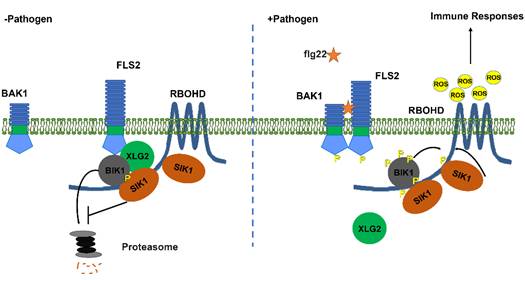The internationally renowned journal "Cell Host & Microbe" (impact factor 17.872) recently published a new study on the crop disease research team of our hospital. The paper is entitled "The MAP4 kinase SIK1 secured robust extracellular ROS burst and anti-bacterial immunity in plants". Associate Professor Zhang Meixiang of the Department of Plant Pathology of our hospital is the first author. The Institute of Plant Protection is the first author. Professor Gitta Coaker of the University of California, Davis is the author of the communication. Professor Sin Daolong, research team of crop disease, and Institute of Genetics and Development, Chinese Academy of Sciences Researcher Zhou Yimin and researcher Liu Jun from the Institute of Microbiology of the Chinese Academy of Sciences participated in the study.
Plants use pattern recognition receptors on the cell surface to perceive pathogen invasion and induce resistance, and active oxygen burst is an important disease-resistance response. Reactive oxygen bursts need to activate the enzyme RBOHD on the plasma membrane, which is responsible for the catalytic oxidation of NADPH, which is a key enzyme for the production of extracellular reactive oxygen species, but the mechanism of fine regulation of the enzyme is still unclear. Previous studies have shown that the receptor-like intracellular protein kinase BIK1 plays an important role in plant disease resistance. It phosphorylates and activates RBOHD to induce the burst of reactive oxygen species after plant-aware pathogens. The study identified a novel protein kinase, SIK1, which indicates that it is another key factor in the disease-resistant signaling pathway. It phosphorylates and stabilizes BIK1 to promote BIK1 activity, and also interacts directly with RBOHD and phosphorylates. To activate its activity. Therefore, the study found that SIK1 is a novel plant core immunoregulatory factor and revealed its molecular mechanism of activating RBOHD to promote ROS.

Schematic diagram of SIK1 regulating plant immunity
Interestingly, SIK1 is highly conserved in higher plants, suggesting that field crops may also adopt a similar mechanism to regulate their own disease resistance and immune response. This study expands the understanding of the innate immune regulation mechanism of plants, and subsequently uses genetic editing techniques to transform this. Proteins provide a theoretical and material basis for improving disease resistance.